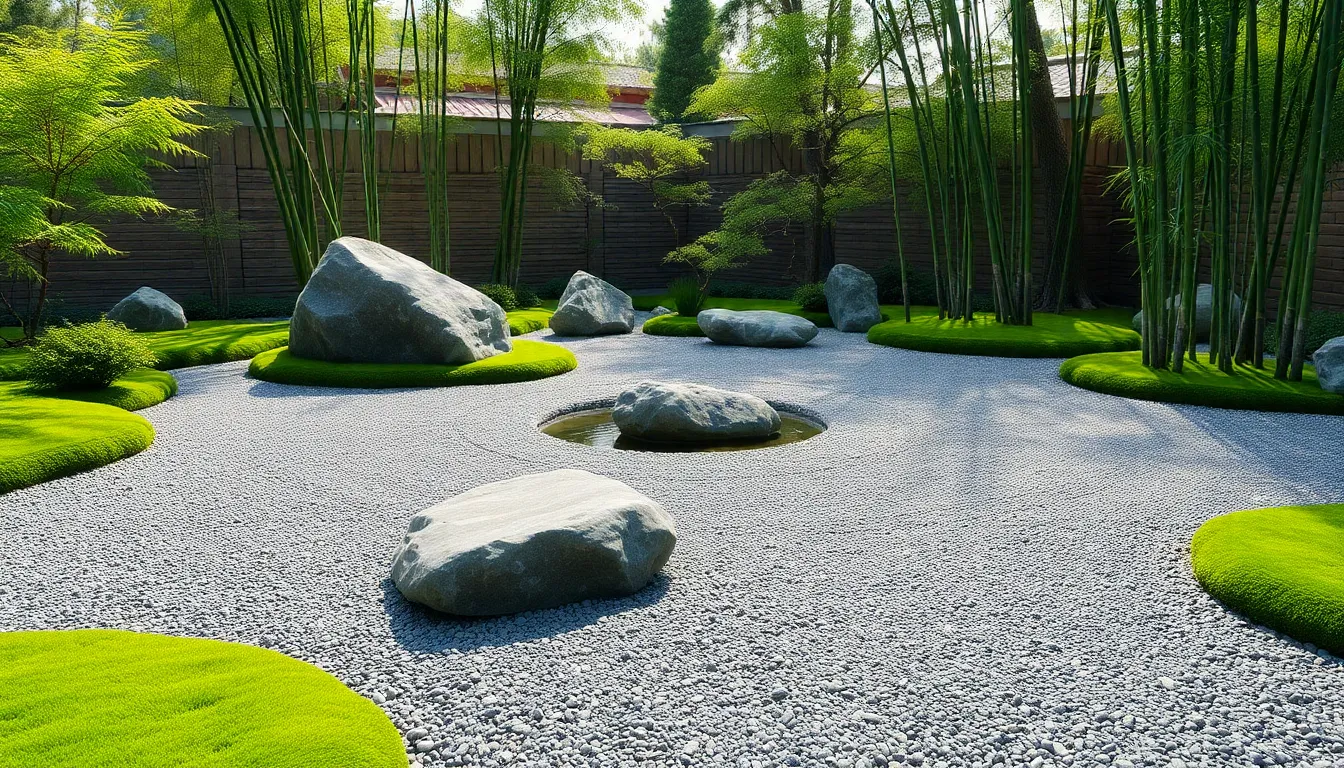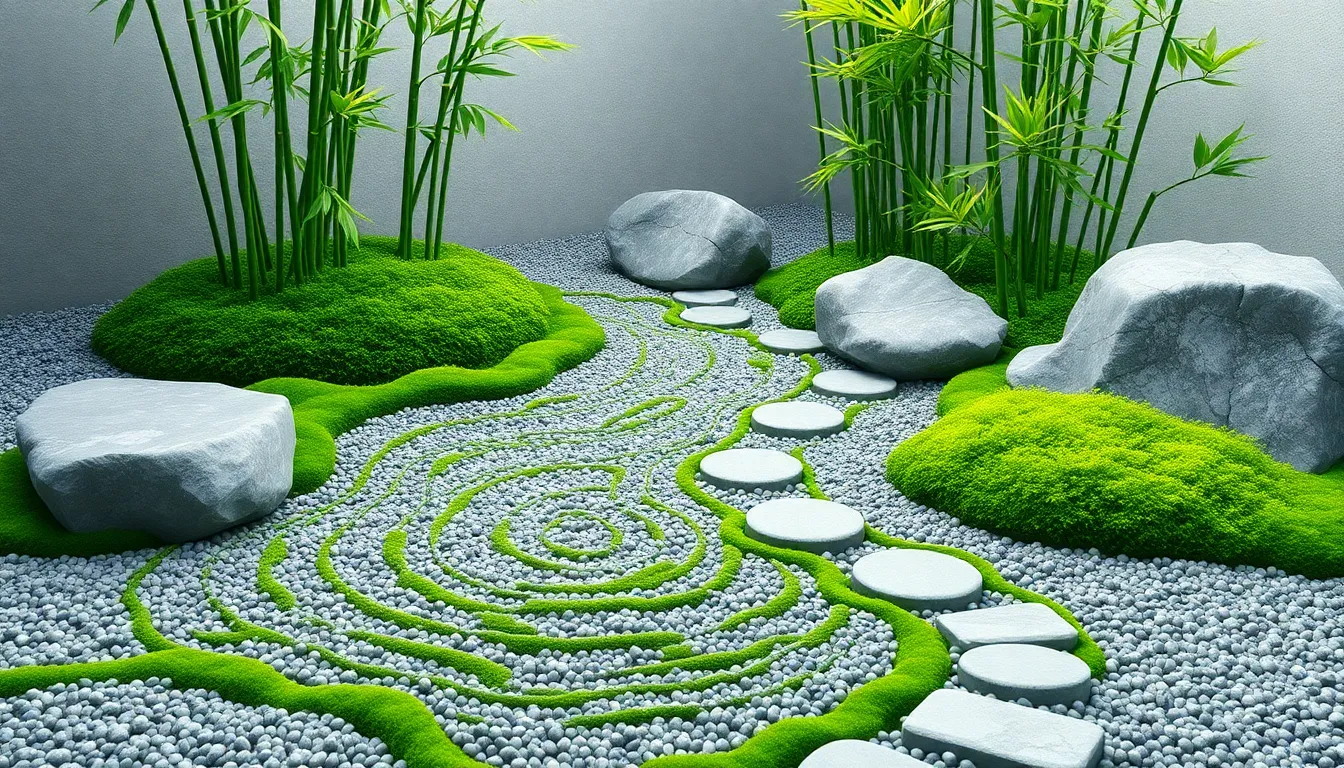In a world that’s often chaotic and overwhelming, the allure of a zen garden can feel like a breath of fresh air. Picture this: a serene space where raked gravel mimics the ripples of water and carefully placed stones invite tranquility. Zen garden design isn’t just about aesthetics; it’s a lifestyle choice that promotes mindfulness and relaxation.
Zen Garden Design
Zen garden design emphasizes tranquility and mindfulness. It incorporates natural elements that promote a serene environment.
Principles of Zen Garden Design
Simplicity defines zen garden design. Each element serves a purpose, whether it’s raked gravel or a positioned stone. Balance maintains harmony between different components. Focus on asymmetry creates interest while avoiding chaos. Natural patterns in the gravel symbolize water ripples, enhancing the overall aesthetic. Incorporating plants, such as moss or bamboo, adds subtle hints of color and texture. Lastly, accessibility remains crucial, allowing movement through the space without disrupting the peace.
Benefits of Zen Gardens
Zen gardens promote mental well-being. These spaces encourage relaxation through their minimalistic appeal. Mindfulness practices often find a conducive environment within these gardens, as they are designed for quiet contemplation. Gardens also lower stress levels, providing an escape from daily chaos. Exposure to green spaces boosts mood and increases focus. Creating a zen garden offers an opportunity for personal reflection and growth, promoting a balanced lifestyle. Additionally, these gardens enhance property value by presenting an attractive, peaceful retreat.
Key Elements of Zen Gardens

Zen gardens feature several key elements that work together to create tranquility and harmony. Each aspect contributes uniquely to the overall design, emphasizing simplicity and balance.
Rocks and Gravel
Rocks and gravel form the foundation of any zen garden. Typically, raked gravel symbolizes water ripples, serving as a visual representation of nature. Large stones act as focal points, adding stability and dimension. Various sizes and shapes ensure visual interest while maintaining an organic feel. Strategically placed rocks provide balance, integrating the hardscape with the overall design. Careful arrangement helps to define spaces for contemplation and meditation.
Plants and Greenery
Plants and greenery introduce life to zen gardens. Moss often thrives in shaded areas, adding vibrant green hues and texture. Bamboo provides vertical interest, swaying gently in the breeze and creating a serene ambiance. Native plants contribute to ecological harmony while attracting beneficial wildlife. Selecting low-maintenance species helps maintain the garden’s tranquility, ensuring that upkeep doesn’t disrupt a sense of peace. The juxtaposition of lush plants against the minimalist hardscape enhances the overall aesthetic and atmosphere.
Water Features and Paths
Water features and paths enhance the sensory experience of a zen garden. Small ponds or streams create soothing sounds, encouraging relaxation and reflection. Smooth stones or gravel paths guide visitors through the garden, inviting them to explore and connect with nature. These pathways often symbolize the journey of life, adding depth to the experience. Integrating water and pathways promotes a seamless flow, inviting a sense of calm as one moves through the space. Each element reinforces the garden’s role as a peaceful retreat.
Designing Your Own Zen Garden
Creating a zen garden involves thoughtful planning and execution to achieve tranquility. Every choice made affects the overall environment and experience.
Choosing the Right Space
Identify a location with minimal distractions. A quiet corner of the yard or a dedicated patio serves well. Ensure the area receives sunlight and shade in balance, promoting plant health. Consider proximity to a window for indoor gardens, allowing natural light to enhance the space. Taking into account the size of the area helps in selecting garden elements that fit appropriately. Place the garden away from noise to maintain a serene atmosphere.
Simple Design Techniques
Adopt minimalistic design techniques to foster relaxation. Begin with gravel, using it to create patterns that represent water ripples. Implement asymmetry, placing stones off-center for visual interest. Introduce focal points like boulders or sculpture to draw the eye naturally. Incorporate plants such as moss or ornamental grasses for texture and color. Ensure pathways are composed of natural materials for an organic feel and easy navigation. Layering elements enhances depth without overcrowding the space. Each design choice should promote harmony, encouraging moments of mindfulness in the garden.
Maintaining Your Zen Garden
Maintaining a zen garden ensures its beauty and tranquility remain over time. Regular attention to detail promotes a serene atmosphere conducive to mindfulness.
Seasonal Care Tips
Winter months require careful attention. Snow accumulation can damage delicate plants or structures. During spring, removing debris and re-raking gravel refreshes the space. Summer maintenance includes checking for weeds and ensuring hydration for plants like moss and bamboo. Autumn brings fallen leaves; clearing them maintains visibility of gravel patterns and prevents decay.
Common Challenges and Solutions
Weeds often arise in zen gardens, disrupting the harmonious aesthetic. Regular weeding prevents them from taking over. Irrigation can pose difficulties, especially for plants in dry regions; using mulch helps retain moisture. Additionally, stones may shift or settle unevenly over time; re-positioning them ensures balance. Pests can also affect plant health; introducing natural deterrents can mitigate their impact effectively.
Conclusion
Creating a zen garden is more than just a landscaping project; it’s an invitation to embrace tranquility and mindfulness. Each carefully chosen element contributes to a serene atmosphere that fosters personal reflection and growth. By prioritizing simplicity and balance, anyone can design a space that not only enhances their property but also nurtures their mental well-being.
Regular maintenance ensures that the garden remains a peaceful retreat, allowing its beauty to flourish through the seasons. Whether it’s through the gentle raking of gravel or the careful placement of stones, the act of tending to a zen garden becomes a meditative practice in itself. This harmonious space ultimately serves as a reminder of the importance of peace in a busy world.

